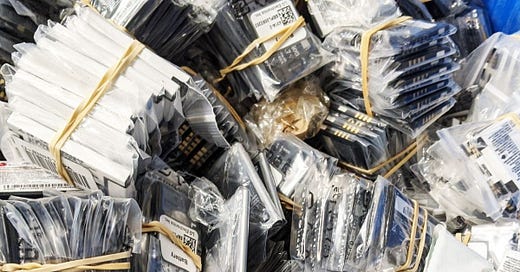This article will serve as an ongoing database for companies in Europe and North America planning to engage in lithium-ion battery recycling. Updates and new company launches will be added to this document as they are released. I will post on social media including a note on Substack when I update the list.
Updated January 25 2024
Companies:
Electra Battery Materials
Fortum
Green Li-ion
Hydrovolt
Infiniti Recycling
Li Industires
Li-Cycle
Librec
Lithion
Mecaware
Mercedes
NICKELHÜTTE AUE
No Canary
Northvolt (ReVolt)
Nth Cycle
Onto
POSX
Primobius
Princeton New Energy
R&D Consortium
ReCell
Recyclico
Redux
Redwood Materials
Roth International
SNAM Groupe
Solvay
Stena Recycling
SungEel Hitech
TES
Tozero
Umicore
Universe Energy
Veolia
Volkswagon
American Battery Technology Company (ABTC)
Location: United States
Website:
https://americanbatterytechnology.com/
Company Description per Website:
ABTC is an advanced technology, first-mover lithium-ion battery recycling and primary battery metal extraction company that utilizes internally developed proprietary techNologies to produce domestically-sourced battery grade critical and strategic metals at substantially lower cost and lower environmental impact than current conventionally sourced battery metals.
Commercial Scale Operations: Mechanical
Feedstock:
Consumer Electronics
Production Scrap
Electric Vehicle Batteries
Battery Energy Storage Systems
Feedstock Source: Unknown (USCAR Grant Ford/GM/Stellantis)
Feedstock Partners: Unknown
Facilities:
University of Reno Applied Science Lab
Tahoe Reno Industrial Center 20k Mtpa LiB Feedstock
Global Development Center Fernley - Suspended
Sorting: Auto/Manual
Consumer Electronics Disassembly: Unknown
Mechanical Disassembly: Yes
Thermal/ Pyrolysis Treatment: no
Mechanical Disassembly Patent: Proprietary (Trade Secert)
Summary of Mechanical Process:
After discharging, the battery undergoes de-manufacturing, separating the jelly roll (two electrodes and a plastic separator) from the casing. This exposes the jelly roll for binder breakdown, usually done after shredding and before leaching. Performing this before size reduction allows the recovery of materials lost during foil separation. The company suggests recovering lithium sulfate (Li2SO4) at this stage, with lithium extraction from the black mass following the removal of transition metals.
Exposed battery components undergo low-pressure milling with an inert medium, promoting electrolyte recovery without generating hydrogen fluoride gas. The resulting solvent is collected and sent to a chemical partner. The slurry then moves to a granulator for size reduction (6-80 mm), separating metallic foils, plastics, and iron. Active electrode materials, already smaller from de-manufacturing, remain unchanged. A screw conveyor transports the material to a flow screen, where BM constituents fall through, while larger metallic foils and plastics proceed to metal and plastic separation.
Pyrometallurgical Process: No
Pyrometallurgical Patent: NA
Summary of Pyrometallurgical Process: NA
Hydrometallurgy: Yes
Hydrometallurgical Patent: Full Hydro Process protected by Trade Secerts LiOH creation covered under a pending patent https://patents.google.com/patent/WO2020205302A1/en
Summary of Hydrometallurgical Process:
Due to the lack of impurities, a low sulfuric acid load leach is employed. After creating a leachate, transition metals undergo separation via solvent extraction. These metals are then purified and crystallized as sulfates, adhering to customer specifications for morphology. Lithium, in the form of lithium sulfate, undergoes splitting and combination with OH- anions, created by water splitting, using stacks of cation/anion/bipolar membranes. The resulting SO4- combines with the released H+ to regenerate H2SO4. Once reaching sufficient concentration, LiOH is filtered and crystallized to produce lithium hydroxide monohydrate according to customer specifications.
Direct Cathode Recycling: No
Products:
Black Mass
Metal Sulfates
Lithium Sulfate
Lithium Carbonate
Lithium Hydroxide
Copper
Aluminuim
Iron Phosphate Oxide
Plastics/Polymers
Graphite
Electrolyte
Business Partners:
BASF
FedEx
DuPont
TechMet-Murcria
Excutives/ViP:
Ryan Melsert CEO/CTO: https://www.linkedin.com/in/ryan-melsert
Andre Meza COO: https://www.linkedin.com/in/andresmeza
Jesse Deutsch CFO: https://www.linkedin.com/in/jesse-deutsch-b2636b4
Scott Jolcover CRO: https://www.linkedin.com/in/scott-jolcover-74245912
Dr. York Smith R&D Director: https://www.linkedin.com/in/york-smith-321b0a11
Anthony Young IR Director: https://www.linkedin.com/in/anthony-young-caia-364196
Tiffiany Moehring Head of Communications & Marketing: https://www.linkedin.com/in/tiffiany-moehring-659aaa5
Mitchel Dreier Director Engineering: https://www.linkedin.com/in/mitchell-dreier-42098913
Opinion:
ABTC has developed a groundbreaking process that revolutionizes the disassembly stage of lithium-ion battery recycling. This innovation has reduced the time and chemical loads required for processing and refining battery-grade metals from the black mass. However, a significant drawback exists: while the front end operates independently of the back end, the hydrometallurgical stage relies entirely on the high-quality, low-impurity black mass obtained from the initial stage.
This is also the draw for the company as their black mass creation system and the product it can create will demand a premium over others that create a product high in copper and other unwanted metals, and many of those will be contaminated with fluoride and other impurities.
Bulldog Analysis Write-up:




